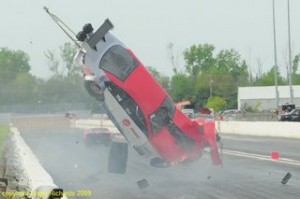Nowhere does logic pay off in this sport… you build a costly car that runs for mere seconds, you race for a purse that more often than not will never pay back the expenses, and even the most skilled driver gambles that a split second will not destroy all that hard work, or result in injury or worse.
 This year at the NHRA Gateway race in St. Louis, a seasoned Fuel driver Melanie Troxel walked away from a crash in Raymond Commisso’s 5.8-second Pro Modified entry, an incident she attributed to her “inexperience. I just didn’t have enough laps.” She went on to say “these cars are a handful,” a sentiment that Rick Stivers would probably agree with given his own spectacular crash that same weekend in the Get Screened America Pro Mod Challenge at the O’Reilly NHRA Midwest Nationals.
This year at the NHRA Gateway race in St. Louis, a seasoned Fuel driver Melanie Troxel walked away from a crash in Raymond Commisso’s 5.8-second Pro Modified entry, an incident she attributed to her “inexperience. I just didn’t have enough laps.” She went on to say “these cars are a handful,” a sentiment that Rick Stivers would probably agree with given his own spectacular crash that same weekend in the Get Screened America Pro Mod Challenge at the O’Reilly NHRA Midwest Nationals.
His 2006 Stratus hit the wall and flipped — what Stivers described as “all hell [breaking] loose – literally.” Both incidents illustrate that in a class of promods with tremendous power (Troxel’s car put out 2,500 hp), crashes are often simply beyond the driver’s control. Both Troxel and Stivers were wearing their seat belts and are lucky; their injuries could have and probably should have been severe.
Not surprisingly, the major factors in this class are the inherent danger, the expense of repairs, and how attractive these high class machines are to thieves. So what makes it worth all the risk?
The remark that I hear across the board is that Pro Mod is the most difficult class to navigate. The cars make a ton of power, and don’t have near the downforce of their bigger nitro brothers. They are a handful to drive, but they are the fastest true doorslammers in existance. Several nitro drivers such as Mike Ashley, Scotty Cannon, Matt Hagan and others have gotten their starts in Pro Mod. And several nitro pilots have also learned much like Melanie how much these cars are underestimated.

 2007 Mustang Build-up
2007 Mustang Build-up